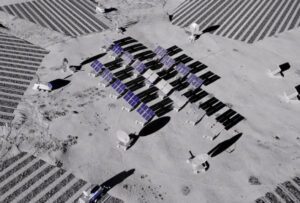It does not look like the beginning of a space-age revolution. It has no gleaming silver hull, no exotic carbon-fiber frame, no science-fiction grace. What Interlune and Vermeer have built—an Earth-tested lunar mining robot—looks like a strange fusion between a child’s sandbox digger and a rugged road trencher. Yet beneath its humble aesthetic lies a quiet, seismic shift in human industry.
This is not a mockup. Not a pitch deck fantasy or concept drawing for a PowerPoint in Silicon Valley. It’s a working prototype. One that has already begun clawing through simulated regolith in controlled Earth environments with one clear objective: to mine helium-3 on the Moon.
Helium-3, a lightweight isotope of helium, has long been mythologized as the holy grail of energy production. But its rarity on Earth has kept it out of reach. Now, as private spaceflight becomes less speculative and more industrial, Interlune is attempting to do something most thought decades away: turn the Moon into an active mining site. Not for gold. Not for water. But for a gas that could transform the way we power cities, accelerate quantum computing, and rethink global energy security.
THE PROMISE OF HELIUM-3: A FUEL FOR POST-FOSSIL CIVILIZATION
Helium-3 is an isotope with no neutrons—an atomic ghost, delicate and elusive. Unlike heavier fuels, it does not emit harmful radiation during nuclear fusion, making it an ideal candidate for clean fusion power. Its potential lies in the type of reaction it enables: a fusion of deuterium (heavy hydrogen) and helium-3 produces almost no radioactive waste and very little neutron radiation. It is, in theory, one of the cleanest energy sources we could ever harness.
But Earth’s natural supply of helium-3 is vanishingly small—around 15 kilograms, globally. The Moon, on the other hand, is rich in the isotope. Billions of years of solar wind have implanted helium-3 atoms into the top layers of the lunar regolith. Thanks to the Moon’s lack of atmosphere and magnetic field, these particles have stayed locked in the dusty soil, waiting.
This is what Interlune is after. And their mining machine is the first serious attempt to harvest it.
INTERLUNE’S MISSION: BRINGING ENERGY BACK TO EARTH
Founded by veterans of Blue Origin and NASA, Interlune’s mission is startling in its clarity: build a functional, economically viable system for lunar resource extraction. Their first focus is helium-3, but the implications are larger.
The robot they’ve created is designed for lunar terrain, not a flat factory floor. It drills roughly three meters deep, targeting the denser regolith layers where helium-3 is most concentrated. Its processing system is engineered to function without water, using a chemical separation technique designed for low-gravity, low-atmosphere conditions. It processes up to 100 metric tons of regolith per hour—a staggering throughput given the difficulty of moving even a few pounds of material in space.
Paired with in-situ testing, robotic automation, and onboard AI, the robot doesn’t just mine. It learns. The machinery collects data on soil composition, adjusts extraction protocols on the fly, and can be remotely upgraded over software networks. The result is a kind of autonomous prospector—a digital pioneer with a tireless work ethic and no need for oxygen.
VERMEER’S ROLE: INDUSTRIAL ROOTS IN AN EXTRATERRESTRIAL CONTEXT
If Interlune is the dreamer, Vermeer is the builder. The Iowa-based company has deep expertise in trenchers, horizontal drills, and large-scale excavation equipment. Their machines have dug pipelines beneath oceans and carved fiber optic highways beneath cities. The transition to lunar conditions may seem radical, but to Vermeer, it is simply another context.
Vermeer’s involvement lends gravity to Interlune’s ambitions. It roots the idea of space mining in terrestrial legacy. This isn’t a tech startup with an abstract blueprint. This is a partnership between space engineers and earthmoving veterans. The machine they’ve built might look rough-hewn, but that’s because it’s meant to survive space. It’s not pretty. It’s durable.
THE MOON AS A RESOURCE HUB: SHIFTING THE CENTER OF GRAVITY
The idea of using the Moon as a resource hub is not new. Visionaries from Konstantin Tsiolkovsky to Buzz Aldrin have envisioned lunar bases and space refueling stations. What is new is the seriousness with which companies like Interlune are executing.
NASA’s Artemis program aims to return humans to the Moon. China has its own plans for lunar bases. ESA, Japan, and India are all investing in lunar infrastructure. And now, private industry is entering the fold—not with grand declarations, but with working hardware.
If Interlune succeeds, it will not just be the first company to extract and return helium-3 from the Moon. It will shift the gravitational center of the energy economy off Earth. That is, perhaps, the most radical implication. The Earth, long considered the sole staging ground for human industry, may become merely one node in a broader economic system.
THE ENERGY QUESTION: BEYOND FOSSIL FUELS AND FUSION FANTASIES
Critics may argue that helium-3 fusion remains speculative. And they’re right to a point. No working commercial fusion reactor yet runs on helium-3. Most current designs are based on deuterium-tritium reactions. But the science is evolving. Helium-3 fusion, while technically demanding, is not out of reach. Several experimental reactors have explored the potential. What has been lacking is not science, but supply.
Interlune is betting that once the resource exists, innovation will follow. It’s the classic chicken-and-egg dilemma of infrastructure: you don’t build a road until someone knows what it connects. Interlune’s machine is laying the foundation—not for the future of space exploration—but for the next chapter in Earth’s energy saga.
And the timing couldn’t be more urgent. With climate crises escalating and fossil fuel alternatives facing scalability limits, helium-3 offers a seductive middle path: cleaner than nuclear, denser than solar, and theoretically scalable to the planetary level.
COMPUTING’S QUIET REVOLUTION: QUANTUM AND HELIUM-3
But helium-3 isn’t just about energy. It’s about computation. Superfluid helium-3 plays a key role in quantum computing and cryogenics. Because of its unique properties—it can reach ultra-low temperatures without solidifying—helium-3 is an essential element in cooling quantum processors. The shortage of helium-3 has, in some ways, bottlenecked progress in advanced computing.
By creating a stable supply line from the Moon, Interlune could unlock not only fusion energy but quantum breakthroughs. The post-silicon future, long hampered by thermal limits and fragile materials, could accelerate under helium-3’s icy breath.
Think about it: the same robot that digs dust on the Moon might help build the AI of tomorrow. It’s not a sci-fi plot. It’s a supply chain.
THE ETHICS AND POLITICS OF LUNAR MINING
Of course, none of this happens in a vacuum. Space mining carries political, legal, and ethical baggage. The 1967 Outer Space Treaty forbids any nation from claiming sovereignty over celestial bodies. But companies? That’s a gray area.
The U.S. and Luxembourg have passed laws allowing commercial space resource rights. Other nations object. China is advancing lunar plans of its own. What happens when private enterprise becomes the gatekeeper of off-world resources? Who gets access? Who benefits?
Interlune’s initiative opens a necessary conversation—not just about technology, but about regulation, equity, and post-Earth politics. The Moon, once a symbol of universal awe, may soon be a battlefield of industry.
WHAT HAPPENS NEXT? THE PATH TO DEPLOYMENT
Interlune is currently testing its prototype under simulated lunar conditions: regolith analogs, vacuum chambers, temperature extremes. The next step is low-gravity testing aboard lunar landers, potentially in partnership with commercial payload programs like NASA’s CLPS (Commercial Lunar Payload Services).
Once surface reliability is confirmed, the company aims to deploy its first operational unit by the early 2030s. It’s an ambitious timeline, but not unfeasible. Private spaceflight is no longer theoretical. With players like SpaceX, Blue Origin, Astrobotic, and Rocket Lab enabling logistics, the infrastructure is catching up to the vision.
Flow
It began with a toy-like machine in a warehouse. A bucket-wheel contraption built not for spectacle, but for soil. And yet this modest miner could become the most important robot of the 21st century.
Not because it flies. But because it digs.
By pulling value from dust, Interlune and Vermeer are reminding us that revolutions are not always glamorous. They are granular. They begin in the dirt. And sometimes, that dirt comes from another world.
As helium-3 wafts silently beneath the Moon’s ancient surface, a new future hums in the background. Not of astronauts waving flags, but of machines quietly, patiently harvesting what Earth never had enough of.
A fuel for clean power. A medium for quantum intelligence. A bridge between celestial bodies and economic opportunity.
It doesn’t look like much.
But maybe that’s the point.
No comments yet.








